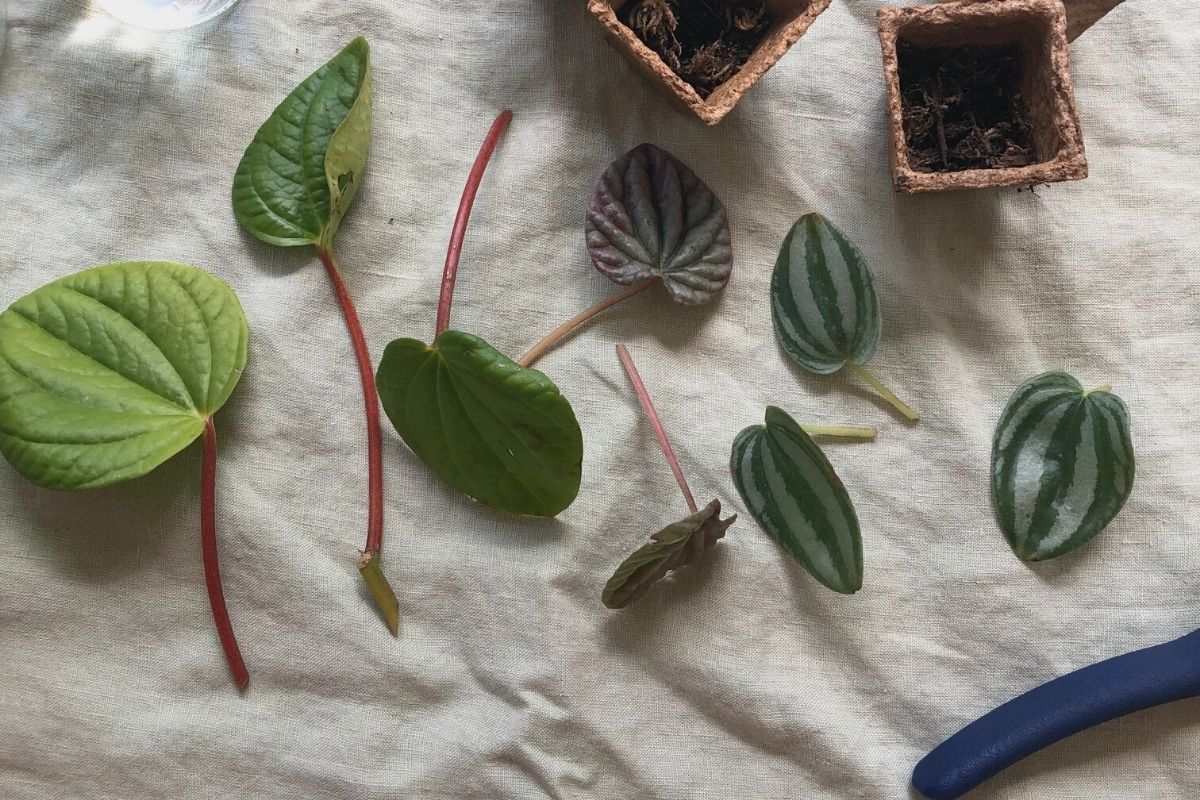Peperomia, also known as the radiator plant, is a genus of perennial epiphytes that are native to tropical regions around the world. There are hundreds of different Peperomia species, but most exhibit similar appearances and behaviors.
The leaves and stem are generally thick and fleshy, and the flowWatermelon Peperomiaers develop on small spikes ranging from yellow to brown. The small plant grows in bush-like formations, rarely reaching a size of over 12 inches.
The compact size and hardy nature of Peperomias have led to their proliferation as a houseplant around many parts of the world. It is simple to propagate Peperomia plants—whether it be through soil, water, or other methods—making it a breeze to grow extra Peperomia plants and share them with friends and family! Propagating peperomia is a simple task, and there are a few different methods that we will explore below.
How to propagate peperomia from cuttings
Growing Peperomia is easiest to do through propagation. Most houseplants that you find in a garden store are the product of propagation—it is a faster and more reliable method than growing from seed. The propagated plants should take after the parent plant, so always pick your hardiest, prettiest Peperomia to take cuttings from. This is why propagation is also called cloning, as the new plants will have the same genetics as their mother plant, essentially making them a “clone.”
When a Peperomia plant is cut, the vegetation responds by forming a “callus” at the wound site. The callus is home to a host of non-specialized cells that—with time, care and, a little luck—should become “specialized” and form new roots and, eventually, an entire new plant.
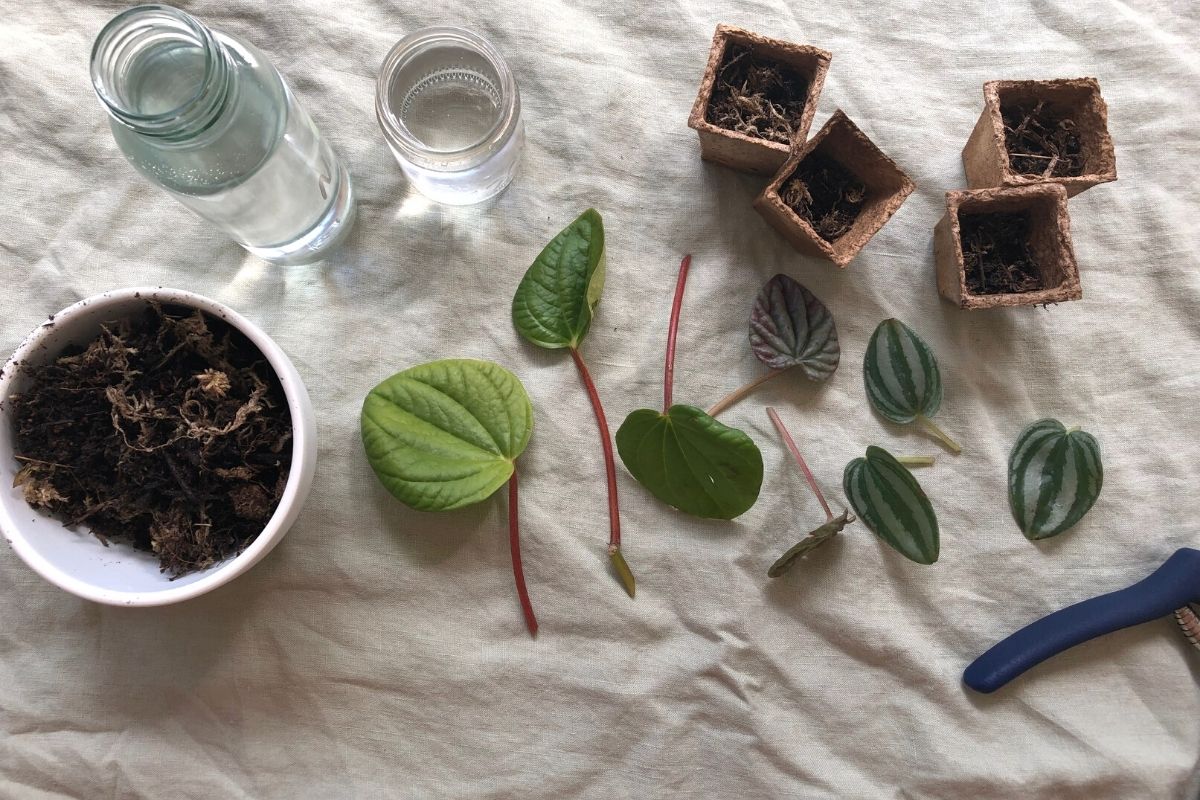
Peperomia cuttings can be taken in two ways: stem cuttings or leaf cuttings. Stem cutting is the most popular method, will generally have the best results, and can be performed with all species of Peperomia. Some Peperomia species are considered semi-succulent and feature succulent leaves that are conducive to leaf cutting propagation. Thinner, weaker leaves may start to decompose before they are able to produce new growth.
- Peperomia propagation from stem cuttings: Using a sterilized sharp knife or pruning shears, take the stem cutting just above the node (where the stem emerges from another branch). Remove the lower leaves—this will create extra wound sites that will hopefully sprout new roots in the coming weeks. Your stem cutting is now ready to be propagated!
- Peperomia propagation from leaf cuttings: Propagation through leaf cuttings works best with solid, hardy Peperomia plants. Choose hearty, healthy leaves when possible, but even tiny leaves should do the trick. Cut just below the leaf with sterilized shears, leaving a small bit of stem attached. You can also use the trimmings from a stem cutting—as you remove the bottom leaf from the stem, try propagating it!
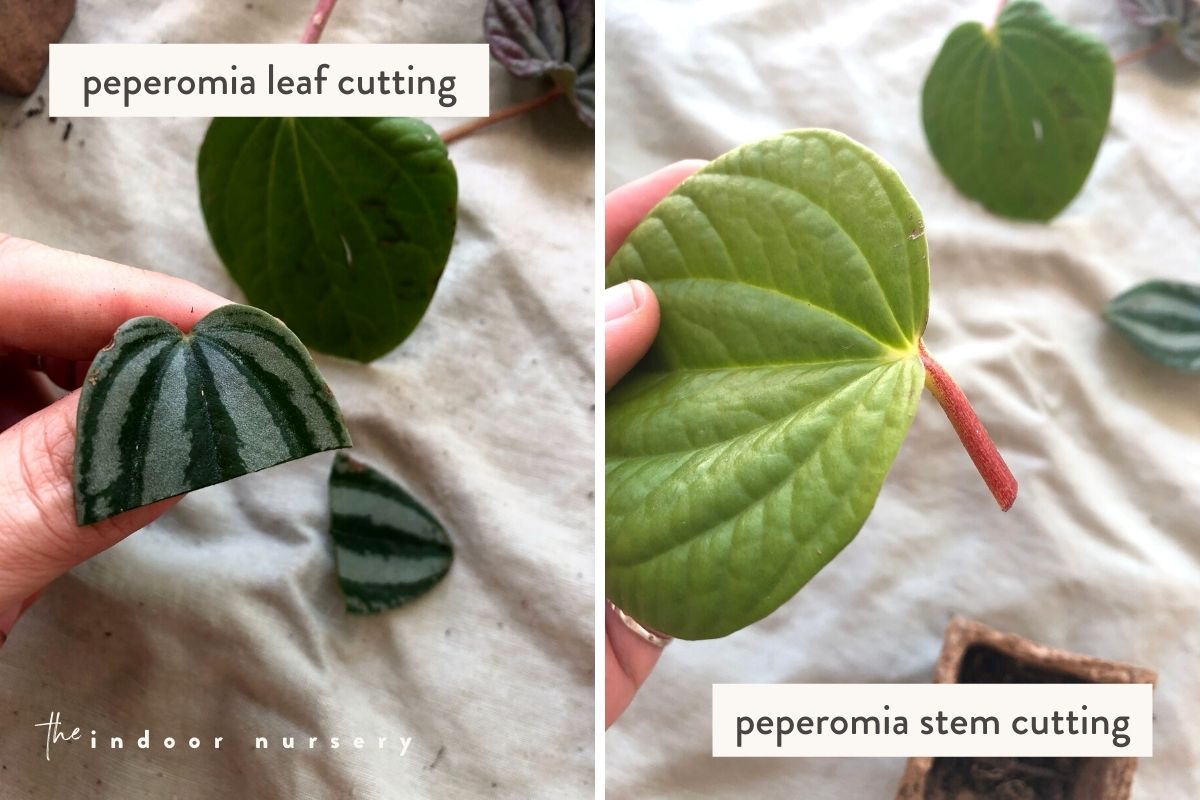
Propagating peperomia in soil
How long it takes: ~20 minutes
What you need:
- potting soil
- perlite
- coco coir
- rooting powder (for soil propagation)
- rooting gel (for water propagation)
Soil makes for an excellent rooting medium, as it holds moisture and provides nutrients when the plant begins to grow. You want your soil moist at all times, but not overly wet.
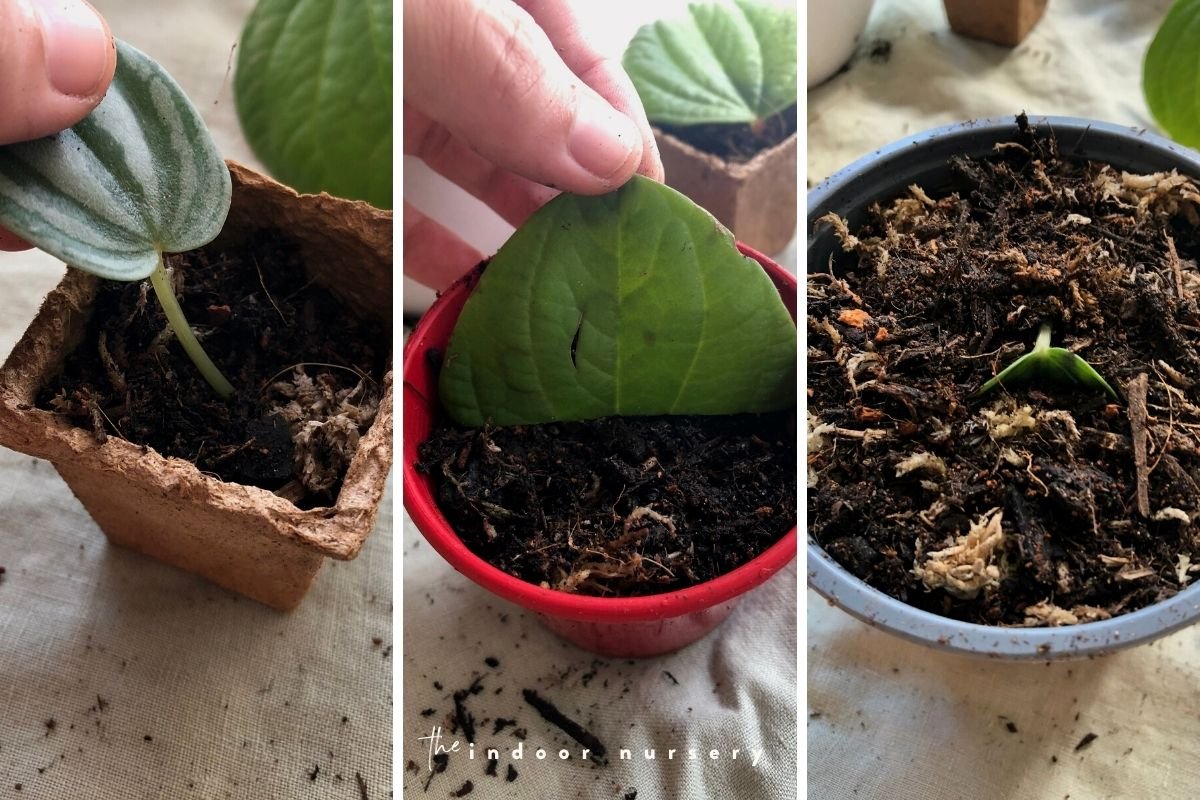
Use a well-draining potting mix, which usually incorporates perlite or vermiculite into the potting soil. Peat moss is also a popular addition when moisture retention is an issue.
- To begin the art of soil propagation, start by taking cuttings from your plants (as described above).
- Dip the stem cuttings or leaf cuttings (the exposed end) into rooting powder. This is an optional step, but highly recommended if you want faster growth.
- Place the cut end into well-draining potting soil and water thoroughly. Make sure your container has a few holes in the bottom so the soil doesn’t become water-logged.
- Place a large plastic bag over the plant to simulate a humid environment and to prevent cold drafts. Make sure that some air is exchanged to avoid mold or other issues from occurring.
- Place them in a window that receives indirect sunlight and start waiting! It can take anywhere from 1 to 3+ weeks for roots and new growth to emerge.
Propagating peperomia in water
You can also use water as a rooting medium. Water propagation works best with stem cuttings, as they can sit in a glass or jar of water (as opposed to a leaf cutting, which will have no stability). You may want to take longer cuttings, depending on the height of your propagation vessel.
- Start your water propagation journey by taking a proper stem cutting from a healthy parent plant.
- Fill a cup, jar, or whatever container you have on hand with tap water. Using a clear glass is fine, but watch out for mold or algae and switch out the vessel immediately if these growths occur.
- Dip the cut end in rooting hormone (optional) to encourage faster root growth. This could save you weeks of waiting!
- Place a clear plastic bag over the jar(s) to provide humidity.
- Wait a few weeks for roots to form! Make sure the water level doesn’t get too low—you want the exposed “calluses” to be submerged at all times.
I stuck my cuttings into a small grow tent we have on the patio. It gets indirect filtered light and has a mister that goes off every morning. I leave the door partially unzipped to allow air flow and try not to let the soil stay too wet for fear of root rot.
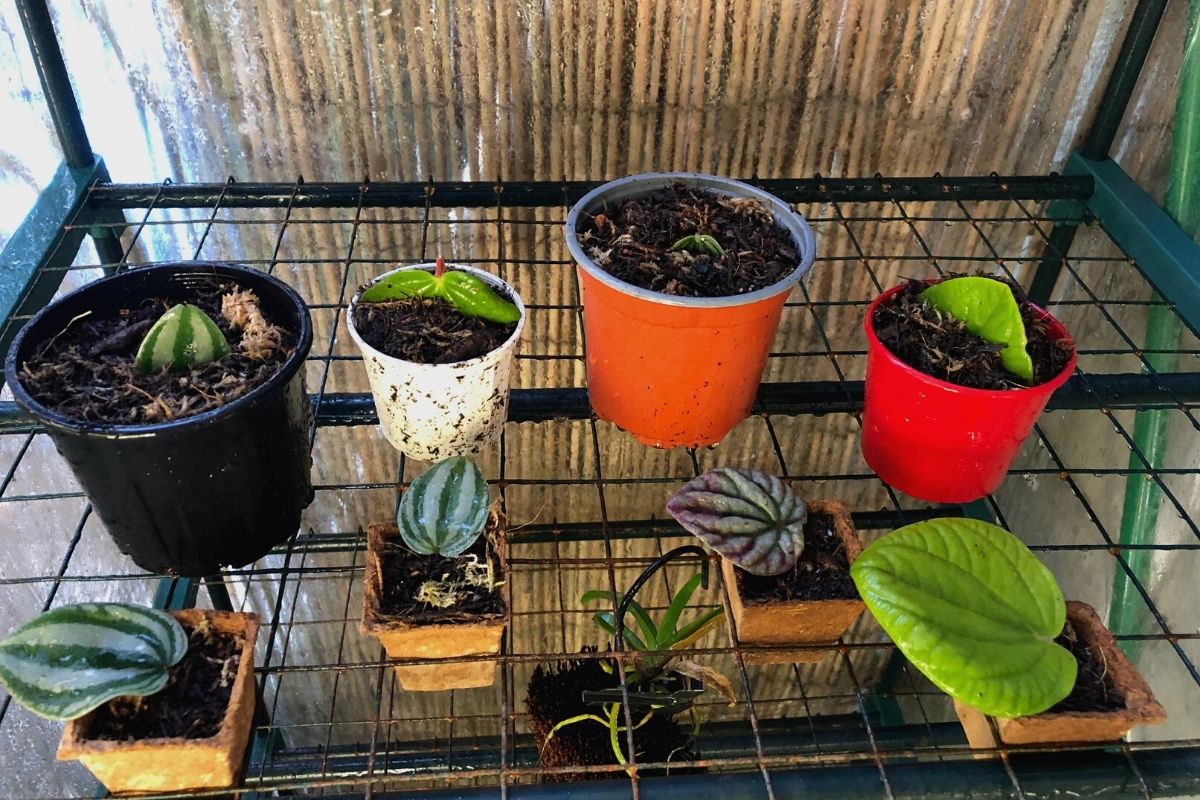
So how did they do? I had a hard time keeping the soil propagation at the right humidity levels and most cuttings ended up rotting. Peperomia watermelon seemed to be the most sensitive to moisture and rotted quickly. The peperomia ripple didn’t completely rot through like the watermelon, but the stem in the soil indeed rotted through.

The peperomia rana verde was the hardiest and propagated happily in every medium. Overall, I found water propagation to be the best, most reliable, and easiest form of propagation.

How to transplant your newly propagated peperomia
Once the Peperomia cuttings show the first sign of new growth and new roots, you will want to transplant them to different pots. Your container size will vary depending on your goals—if this is the transplant’s final home, you will want a pot around 12″ in diameter. Otherwise, any container will do, as long as it has drainage holes in the bottom.
Fill the new containers with well-draining soil. Use a high-quality potting mix designed for houseplants (or craft your own!). Dig a small hole for each of the new plants, place them in, and backfill with soil. Tamp down lightly and water thoroughly.
In their natural habitat, Peperomia grows along the forest floor and up the sides of trees and other plants.
To simulate this environment, place your plants near a window. Avoid direct sunlight—medium to bright, indirect light is best. If given too little light, the plants will not grow properly. Water frequently for a few weeks while the baby plant becomes accustomed to its new home. Once established, only water when the soil is dry to a depth of 1 to 2 inches. Read our guide on peperomia plant care for more details.
What peperomia species are popular?
- Peperomia argyreia, also known as the Watermelon Peperomia, is a small shrub that only grows to around 8 inches tall. Its compact size and easy care have led to its immense popularity as a houseplant. This species enjoys drier soil and will quickly show distress if left to sit in soggy soil. The common name comes from the patterns on the leaves, which resemble the rind of a watermelon, as well as the red-colored stems. P. Argyreia is hardy down to 50° F, and the foliage is not toxic to pets or children.
- Peperomia Obtusifolia, also known as the Baby Rubber Plant, features thick, glossy leaves and a maximum height of around 2 feet. The stems are pink and the conical flowers are cream-colored. Variegated Peperomia plants are popular, with different shades of white, light green, and dark green being incorporated into the leaves. As with other species, P. Obtusifolia enjoys indirect light and a moderate amount of humidity. The Baby Rubber Plant is known to be toxic to humans, but only if ingested. Keep curious children and pets away!
- Peperomia caperata goes by many names, including Emerald Ripple, Metallic Peperomia, Ivy-Leaf Peperomia, Silver Heart and others. The plethora of common names comes from the unique, hard-to-describe appearance that most of these plants exhibit—the leaves appear wrinkled or “rippled” and have a shine to them. The heart-shaped leaves will vary in color, but they often have a deep-purple hue. Mature plants end up at heights around 8 inches, but this species will sprawl and branch more than others. P. caperata is prone to root rot, so make sure your soil drains well. Indirect lighting and moderate humidity are best—the species is known to perform well in office spaces with florescent lighting.
- Peperomia graveolens is a unique species that looks more like a succulent than a tropical houseplant. The leaves are thick and glossy, with green coloring on top and red or pink underneath. The plants rarely grow taller than 10 inches, making them easy to contain and care for. If you are still learning how to propagate Peperomia, this is a great species to test out your skills.

